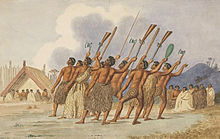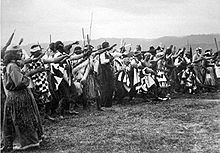- Haka
-
This article is about the traditional Māori dance genre. For other uses, including use in sport and popular culture, see Haka (disambiguation).
Haka (singular is the same as plural: haka) is a traditional ancestral war cry, dance or challenge from the Māori people of New Zealand. It is a posture dance performed by a group, with vigorous movements and stamping of the feet with rhythmically shouted accompaniment.[1] The New Zealand rugby team's practice of performing a haka before their matches has made the dance more widely known around the world.
Contents
History
Although the use of haka by the All Blacks rugby union team and the Kiwis rugby league team has made one type of haka familiar, it has led to misconceptions.[2] Haka are not exclusively war dances or performed only by men.[3] Some are performed by women, others by mixed groups, and some simple haka are performed by children. Haka are performed for various reasons: for amusement, as a hearty welcome to distinguished guests, or to acknowledge great achievements or occasions (McLean 1996:46–47).
War haka (peruperu) were originally performed by warriors before a battle, proclaiming their strength and prowess in order to intimidate the opposition. Today, haka constitute an integral part of formal or official welcome ceremonies for distinguished visitors or foreign dignitaries, serving to impart a sense of the importance of the occasion.
Various actions are employed in the course of a performance, including facial contortions such as showing the whites of the eyes and the poking out of the tongue, and a wide variety of vigorous body actions such as slapping the hands against the body and stamping of the feet. As well as chanted words, a variety of cries and grunts are used. Haka may be understood as a kind of symphony in which the different parts of the body represent many instruments. The hands, arms, legs, feet, voice, eyes, tongue and the body as a whole combine to express courage, annoyance, joy or other feelings relevant to the purpose of the occasion.
Types
The various types of haka include whakatu waewae, tutu ngarahu and peruperu. The peruperu is characterised by leaps during which the legs are pressed under the body. In former times, the peruperu was performed before a battle in order to invoke the god of war and to discourage and frighten the enemy. It involved fierce facial expressions and grimaces, poking out of the tongue, eye bulging, grunts and cries, and the waving of weapons. If the haka was not performed in total unison, this was regarded as a bad omen for the battle. Often, warriors went naked into battle, apart from a plaited flax belt around the waist. The aim of the warriors was to kill all the members of the enemy war party, so that no survivors would remain to undertake revenge.
The tutu ngarahu also involves jumping, but from side to side, while in the whakatu waewae no jumping occurs. Another kind of haka performed without weapons is the ngeri, the purpose of which was to motivate the warriors psychologically. The movements are very free, and each performer is expected to be expressive of their feelings. Manawa wera haka were generally associated with funerals or other occasions involving death. Like the ngeri they were performed without weapons, and there was little or no choreographed movement.
The most well-known haka is "Ka Mate", attributed to Te Rauparaha, war leader of the Ngāti Toa tribe. The "Ka Mate" haka is classified as a haka taparahi – a ceremonial haka. "Ka Mate" is about the cunning ruse Te Rauparaha used to outwit his enemies, and may be interpreted as "a celebration of the triumph of life over death" (Pōmare 2006).
Gender of participants
Most haka are performed by men, with the female role, if any, limited to providing support by singing in the background. There are however some haka which are performed predominantly by women – one of the most well-known being the Ngāti Porou haka "Ka Panapana"[4]
Mythology
According to Māori mythology, the sun god, Tama-nui-te-rā, had two wives, the Summer Maid, Hine-raumati, and the Winter Maid, Hine-takurua. Haka originated in the coming of Hine-raumati, whose presence on still, hot days was revealed in a quivering appearance in the air. This was the haka of Tāne-rore, the son of Hine-raumati and Tama-nui-te-rā.[5]
See also
- Haka of the All Blacks
- Haka in popular culture
- Kapa haka
- Kailao
- Māori music
- Siva tau
- Cibi
- Hula
- Battle trance
- Battle cry
- Military music
References and notes
- ^ The group of people performing a haka is referred to as a kapa haka (kapa meaning row or rank). The Māori word haka has cognates in other Polynesian languages, for example: Tongan haka, 'hand action while singing'; Samoan saʻa, Tokelau haka, Rarotongan ʻaka, Hawaiian haʻa, Marquesan haka, all meaning 'dance'; Mangarevan ʻaka, 'to dance in traditional fashion; dance accompanied by chant, usually of a warlike nature'. In some languages, the meaning is divergent, for example in Tikopia saka means to 'perform rites in traditional ritual system'. The form reconstructed for Proto-Polynesian is *saka, deriving ultimately from Proto-Oceanic *saŋka(g).
- ^ All Black's Haka [1].
- ^ Haka is also the plural form in Māori. [2]
- ^ "East Coasters lead Kapa Haka group in Timor Leste ", NZ Army website
- ^ A. H. McLintock, ed (1966). "Haka". An Encyclopaedia of New Zealand. http://www.teara.govt.nz/1966/H/Haka/Haka/en. Retrieved 2009-04-26.
- McLean, Mervyn, 1996. Maori music. Auckland: Auckland University Press.
- M. Pōmare, 'Ngāti Toarangatira – Chant composed by Te Rauparaha', Te Ara – the Encyclopedia of New Zealand, updated 26-Sep-2006, [3]
External links
- Haka – A New Zealand icon
- Photo of Maori Battalion soldiers performing a haka in Egypt during the Second World War
- A haka performed by women, supported by men singing in the background
- A haka performed by children (Te Kapa Haka o Manawa Tapu)
- Impressions of a national kapa haka contest
- Haka in An Encyclopaedia of New Zealand, edited by A. H. McLintock, originally published in 1966.
List of resources about traditional arts and culture of OceaniaArt ahu · Australia · Austronesia · Cook Islands · Hawaiʻi · kapa (Hawaiʻi) · lei (Hawaii) · magimagi · Māori · moai · New Zealand · nguzu nguzu · Oceania · Papua New Guinea · reimiro · tā moko · tapa ["masi" (Fiji), "ngatu" (Tonga), "siapo" (Sāmoa), " ʻuha" (Rotuma)] · tabua · ta'ovala · tattoo · tēfui · tivaivaiBroad culture Geo-specific, general Australia · Australian Aboriginal astronomy · Austronesia · Caroline Islands, -Pwo · Chatham Islands · Cook Islands · Easter Island · Fiji, -Lau Islands, -traditions and ceremonies · Guam · Hawaiʻi, -Lomilomi massage · Kiribati · French Polynesia's Marquesas Islands · Marshall Islands, -Stick charts of · Federated States of Micronesia · Nauru · New Caledonia · New Zealand · Niue · Norfolk Island · Palau · Papua New Guinea · Pitcairn Islands · Sāmoa · Solomon Islands · Tonga · Torres Strait Islands · Tuvalu · Vanuatu · Wallis and Futuna · Yap, -navigation, -Weriyeng navigation schoolCanoes Aboriginal Dugout · Alingano Maisu · Drua · Dugout (boat) · Hawaiʻiloa · Hōkūleʻa · Modern Hawaiian outrigger · Māori migration · Outrigger · Polynesian sailing · Proa · Waka,-List of · WalapDance Festivals Australia's Garma Festival · Hawaiʻi's Aloha Festivals, Merrie Monarch Festival, and World Invitational Hula Festival · Fiji · New Zealand's Pasifika Festival · The Pacific Community's Festival of Pacific Arts · Festivals in Papua New GuineaLanguages by areaLanguages of Oceania Sovereign states - Australia
- East Timor (Timor-Leste)
- Fiji
- Indonesia
- Kiribati
- Marshall Islands
- Federated States of Micronesia
- Nauru
- New Zealand
- Palau
- Papua New Guinea
- Samoa
- Solomon Islands
- Tonga
- Tuvalu
- Vanuatu
Dependencies and
other territories- American Samoa
- Christmas Island
- Cocos (Keeling) Islands
- Cook Islands
- Easter Island
- French Polynesia
- Guam
- Hawaii
- New Caledonia
- Niue
- Norfolk Island
- Northern Mariana Islands
- Pitcairn Islands
- Tokelau
- Wallis and Futuna
by categoryLiterature Literature of Oceania Sovereign states - Australia
- East Timor (Timor-Leste)
- Fiji
- Indonesia
- Kiribati
- Marshall Islands
- Federated States of Micronesia
- Nauru
- New Zealand
- Palau
- Papua New Guinea
- Samoa
- Solomon Islands
- Tonga
- Tuvalu
- Vanuatu
Dependencies and
other territories- American Samoa
- Christmas Island
- Cocos (Keeling) Islands
- Cook Islands
- Easter Island
- French Polynesia
- Guam
- Hawaii
- New Caledonia
- Niue
- Norfolk Island
- Northern Mariana Islands
- Pitcairn Islands
- Tokelau
- Wallis and Futuna
Music Austral Islands (French Polynesia) · Australia · Austronesia · Cook Islands · Easter Island · Fiji · Guam · Hawaiʻi · Kiribati · Lali · Māori · Melanesia · Northern Mariana Islands · Micronesia · Federated States of Micronesia · Nauru · New Caledonia · New Zealand · Niue · Palau · Papua New Guinea · Polynesia · Sāmoa · Slit drum · Solomon Islands · Tahiti · Tokelau · Tonga · Tuvalu · Vanuatu · Wallis and FutunaMythology Australian Aboriginal · Fijian · Māori · Melanesian · Menehune · Micronesian · Oceanian legendary creatures · Polynesian · Rapa Nui · VanuatuPeople Indigneous Australian · Austronesian · Chamorro · Chatham Islander (Moriori or Rekohu) · Fijian · Hawaiian (kānaka maoli) · Māori · Marshallese · Melanesian · Micronesian · Negrito · Norfolk Islander · Papuan · Polynesian · Indigenous Polynesian (Mā’ohi) · Rapanui · Rotuman · Samoan · Tahitian · Tongan · Torres Strait IslanderReligion Religion in Oceania Sovereign states Dependencies and
other territories- American Samoa
- Christmas Island
- Cocos (Keeling) Islands
- Cook Islands
- Easter Island
- French Polynesia
- Guam
- Hawaii
- New Caledonia
- Niue
- Norfolk Island
- Northern Mariana Islands
- Pitcairn Islands
- Tokelau
- Wallis and Futuna
Not included: Oceanian: cinema, (indigenous) currency, dress, folkore, cuisine. Also see Category:Oceanian culture.Categories:- Haka
- Māori culture
- Māori words and phrases
- Ritual dances
- War dances
- Dances of Polynesia
Wikimedia Foundation. 2010.




